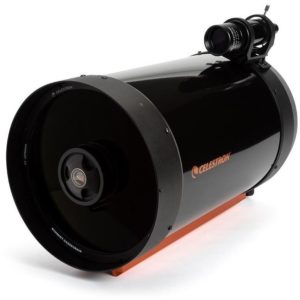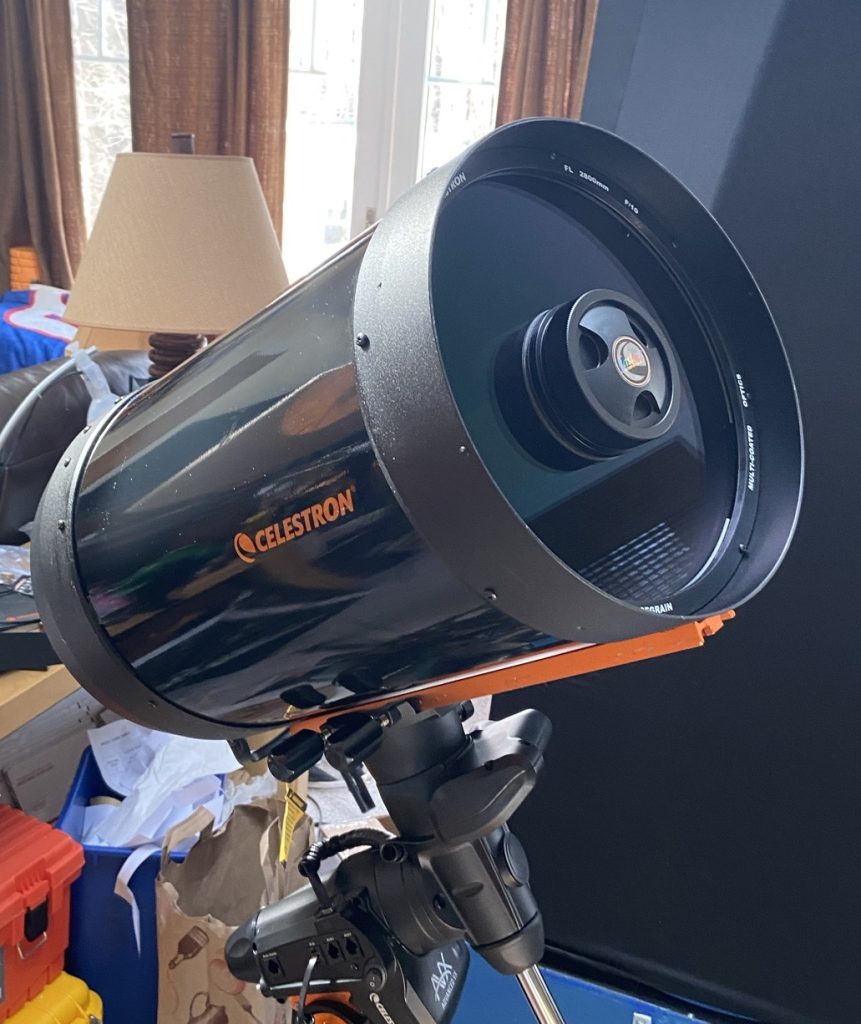The C9.25 is the second newest entry in Celestron’s line of Schmidt-Cassegrain telescopes and probably their least often purchased telescope, right after the gigantic C14.
The C9.25 was introduced in the 1990s as a telescope that came in a low-cost bundle with Losmandy’s GM-8 mount, which was the new back in the day. The bundle was marketed by Celestron.
The C9.25 has always advertised its Starbright coating and water-white corrector-glass – and most of the ones around today are newer models with StarBright XLT coatings.
Only a handful of C9.25s has ever been sold on a fork mounting, like the ultra-rare Ultima 9.25 (of which maybe 300 were made), the CPC 9.25, and the currently available NexStar Evolution 9.25 (which is technically a 1-armed fork mount). None have been hugely popular.
Optics & Construction Of C11
The C11 is a standard Schmidt-Cassegrain with a spherical f/2 primary mirror, Schmidt corrector, and a 5x amplifying secondary mirror, making for a system focal length of f/10. Like almost every SCT focusing is accomplished by moving the primary mirror. This configuration can induce image shift while focusing, which is annoying when observing at high power or conducting planetary imaging, and mirror flops can ruin long exposures. If you’re planning on imaging of any sort with your C11 it’s best to find an aftermarket solution to lock the primary mirror in place if possible and at least fine-tune your focus with a Crayford focuser screwed onto the back to avoid both image shift and mirror flop.

Unlike 9.25” and smaller SCTs the C11 uses a large 3.25” accessory thread on the back, which can be used to mount various heavy-duty accessories, but an adapter to use the standard 2” SCT accessory thread is included with the scope.
Newer C11s have a carry handle attached to the back. While I would probably not recommend carrying the scope with one hand, this handle is a nice convenience. Additionally, the front corrector cover rotates and clicks into place so it doesn’t easily fall off while moving the scope.
The newer C11 XLT uses StarBright XLT multicoatings and water white corrector glass. Compared to my older orange tubed scope there is a slight but detectable improvement in image brightness.
Accessories
Obviously, with an OTA only you shouldn’t be too concerned about accessories since you presumably already have them, but I thought it prudent to mention the few included with the scope here anyway.
The C11 XLT is pretty much always supplied with a straight-through 50mm finderscope of decent quality. While you probably will be using this scope on a GoTo mount and thus won’t need a large-aperture finderscope for anything, the inclusion is a nice bonus.
Additionally, the scope includes a 25mm E-Lux Plossl, 1.25” prism star diagonal, and a 1.25” visual back. To get the most out of your C11 you really need a 2” diagonal and wide-field 2” eyepieces, due to the scope’s ultra-long focal length.
Lastly, the C11 is available with either a Vixen (CG-5) style or Losmandy (CGE) style dovetail plate. In almost all circumstances you will probably want the latter since pretty much all the mounts you’d want to use with a C11 take Losmandy style dovetails.
Usage
The C11 is ideal for planetary imagers thanks to its large aperture and long focal length. With a heavy-duty equatorial mount and focal reducer, it is also usable for deep-sky imaging, and the C11’s HyperStar compatibility allows you to shoot at an ultra-fast f/2 focal ratio.
The C11’s long focal length and large aperture make it a great tool for the visual study of smaller deep-sky objects like galaxies and globular star clusters, as well as lunar and planetary observation. My personal C11 is my default choice for observing these types of objects.
It should be noted that while the C11 is usually capable of up to 600x or so, conditions will often limit you to half or even less than half of that magnification and you should always make sure the scope is adequately collimated and cooled down before you blame the optics for providing less-than-sharp images.
Mounting Options

For deep-sky astrophotography, you want as heavy-duty a mount as possible for the C11. Something with a 60-pound or greater weight capacity is preferable. Mounts of this size are generally expensive and not particularly portable, so if you plan on using your C11 for deep-sky imaging you should plan on either storing the setup on a lockable dolly and rolling it out of the garage, or in some kind of observatory. Autoguiding is also absolutely required, and you should probably use an 80mm guide scope for optimum performance. These can be attached by obtaining and installing a second dovetail to the top of the C11 and piggybacking the guide scope assembly on top.
For visual use, planetary imaging, and perhaps use with the HyperStar system, something in the EQ6 class size range like the Orion Atlas, Celestron CGEM, or Sky-Watcher EQ6 is recommended. Any of these mounts can be set up with the C11 by one person in about ten minutes and is quite stable. The hardest part is hoisting the tube onto the mount, which is mainly due to the scope’s large size and the height it must be lifted to and not the weight. However, all of this can be done by a single, average strength user without too much physical strain and the process is no more physically demanding than setting up a solid-tubes 12” Dobsonian.
Celestron sells the C11 bundled with their Advanced VX mount and this combination will indeed function, but it is putting some level of strain on the gears and can be frightening to use in windy conditions. Other EQ5-class mounts usually have smaller (1.75” vs 2”) tripod legs than the AVX and are completely out of the question for use with the C11.
Conclusion
If you are interested in primarily observing the moon and planets, double stars, and small deep-sky objects with a portable setup, Celestron’s C11 XLT is an excellent choice if coupled with an EQ6-class mount. And if you are fortunate to have a garage or observatory, the C11 is also a great deep-sky imaging platform. I would definitely recommend one, though this is a serious, big-league telescope. If you are a beginner I would
